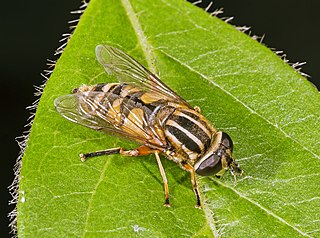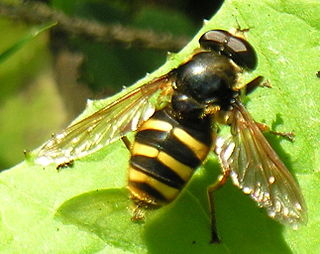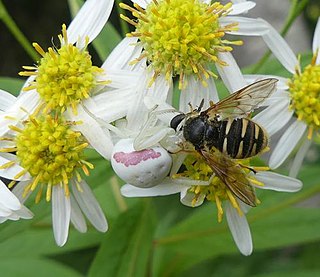
Eristalinae are one of the four subfamilies of the fly family Syrphidae, or hoverflies. A well-known species included in this subfamily is the dronefly, Eristalis tenax.

Helophilus are a diverse genus of moderate to large hoverflies, that appear somewhat bee-like. This genus comprises two subgenera: Helophilus and Pilinasica. Larvae filter-feed in organic rich water. All Helophilus adults have a distinctive lengthwise striped thorax and a transverse striped abdomen.

Sercomyia are large flies with species that are bee mimics both short pile and long pile. Sericomyiine flower flies are common in boreal forests across the Holarctic region and southward at higher elevations into the Oriental and Neotropical regions. Sericomyia species have larvae of the rat-tailed maggot type, often found in ponds rich in decomposing vegetation where they filter out microorganisms as their food

Sericomyia silentis, is a species of hoverfly. It is widespread throughout the Palearctic but normally encountered in small numbers in mountain regions and moorland and bog locations.

Sericomyia lappona, is a species of hoverfly. It is widespread throughout the Palearctic.

Sericomyia chrysotoxoides ,, the Oblique-banded Pond Fly , is a common species of syrphid fly observed across the eastern half of North America and in the Rocky Mountains. Syrphid flies are also known as Hover Flies or Flower Flies because the adults are frequently found hovering around flowers from which they feed on nectar and pollen. Adults are 9.6–1,315.3 mm (0.38–51.78 in) long, black with yellow bands, less prominent in the male. The larvae of this genus are known as rat tailed maggots for the long posterior breathing tube.

Arctophila is a subgenus of hoverflies, in the genus Sericomyia from the family Syrphidae, in the order Diptera, comprising several hairy, bee-mimicking species.

Sericomyia militaria, commonly known as the narrow-banded pond fly, is a common species of syrphid fly observed across northern North America. Syrphid flies are also known as Hover Flies or Flower Flies because the adults are frequently found hovering around flowers from which they feed on nectar and pollen. Adults are 11.7–17.1 mm (0.46–0.67 in) long, mostly black with narrow yellow abdominal markings. The larvae of this genus are known as rat tailed maggots for the long posterior breathing tube.

Sericomyia (Arctophila) superbiens is a Palearctic species of hoverfly. It is a bumblebee mimic.

Sericomyia transversa , the Yellow-spotted Pond Fly , is an uncommon species of syrphid fly observed in northeastern North America.. Hoverflies can remain nearly motionless in flight. The adults are also known as flower flies for they are commonly found on flowers, from which they get both energy-giving nectar and protein-rich pollen. The larvae of this genus are known as rat tailed maggots for the long posterior breathing tube.

Sericomyia lata , the White-spotted Pond Fly , is a common species of syrphid fly observed across North America, concentrated in the east. Syrphid flies are also known as Hover Flies or Flower Flies because the adults are frequently found hovering around flowers from which they feed on nectar and pollen. Adults are 11.6–15.2 mm (0.46–0.60 in) long and black with large white abdominal spots. The larvae of this genus are known as rat tailed maggots for the long posterior breathing tube.

Sphecomyia is a genus of hoverfly in the family Syrphidae. There are about 16 described species in Sphecomyia.

Ocyptamus cubanus is a species of syrphid fly in the family Syrphidae.

Sericomyia bifasciata, the Long-nosed Pond Fly, is an uncommon species of syrphid fly. They have been observed from the northeastern part of North America. Hoverflies get their names from the ability to remain nearly motionless while in flight. The adults are also known as flower flies for they are commonly found around and on flowers, from which they get both energy-giving nectar and protein-rich pollen. The larvae in the genus Sericomyia are known as the rat-tailed with a long breathing tube taylored for aquatic environments. The larvae for this species are unknown.

Sericomyia chalcopyga is a species of syrphid fly in the family Syrphidae.
Chrysobothris sexfasciata is a species of metallic wood-boring beetle in the family Buprestidae. It is found in the Caribbean Sea and North America.
Sphecomyia sexfasciata is a species of syrphid fly in the family Syrphidae.
Sericomyia carolinensis, is a rare species in the family Syrphidae, found in the Southeastern part of the United States. It is distinguished by its all yellow face, single pair of small narrow yellow spots, and yellow pilose scutellum. Adults noted feeding on pear blossoms. The larval stage is unknown but is likely a "rat tailed" type larvae inhabiting nutrient rich waters, typical for the genus Sericomyia.
Total of 245 species either found or highly expected to be found in New York.













